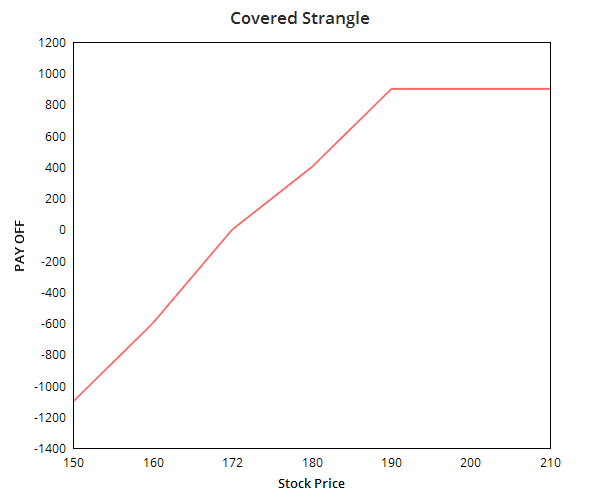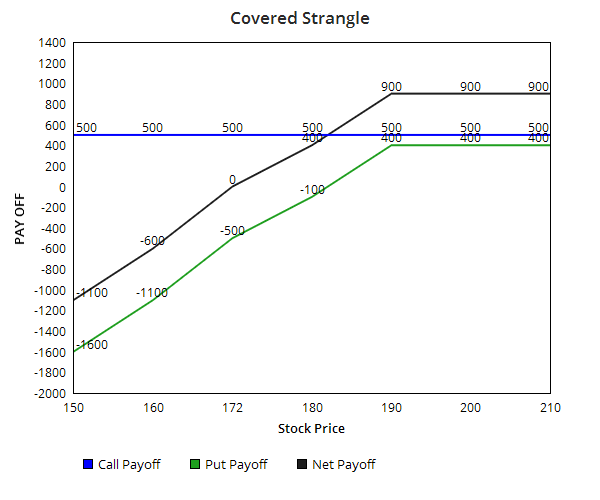 Zerodha (Trading & Demat Account)
Zerodha (Trading & Demat Account)
FREE Equity Delivery and MF
Flat ₹20/trade Intra-day/F&O
 Zerodha (Trading & Demat Account)
Zerodha (Trading & Demat Account)
FREE Equity Delivery and MF
Flat ₹20/trade Intra-day/F&O

|
|
Published on Thursday, August 9, 2018 | Modified on Wednesday, August 21, 2024

| Strategy Level | Advance |
| Instruments Traded | Call + Put + Underlying |
| Number of Positions | 3 |
| Market View | Bullish |
| Risk Profile | Limited |
| Reward Profile | Limited |
| Breakeven Point | two break-even points |
The covered strangle option strategy is a bullish strategy. The strategy is created by owning or buying a stock and selling an OTM Call and OTM Put. It is called covered strangle because the upside risk of the strangle is covered or minimized.
The strategy is perfect to use when you are prepared to sell the holding or bought shares at a higher price if the market moves up but would also is ready to buy more shares if the market moves downwards.
The profit and in this strategy is unlimited while the risk is only on the downside.
A covered strangle strategy can be used when you are bullish on the market but also want to cover any downside risk. You are prepared to sell the shares on profit but are also willing to buy more shares in case the prices fall.
Suppose shares of ABC company is currently trading at Rs 200. You buy 100 shares of the company or are already holding it. You sell an OTM Call at the strike price of Rs 210 at a premium of Rs 10 per share and OTM Put at the strike price of Rs 190 at Rs 8 per share. The lot size is 50 shares.
|
Current Market Price of ABC stock |
200 |
|
Option Lot Size |
50 |
|
Strike Price of Call Option |
210 |
|
Premium Received |
10 X 50= Rs 500 |
|
Strike Price of Put Option |
190 |
|
Premium Received |
8 X 50= Rs 400 |
|
Break Even Point Upper = Strike Price of Short Call + Net Premium Received Lower = Strike Price of Short Put - Net Premium Received |
Upper = 220 Lower = 182 |
|
Nifty Closing Price (CP) |
Call Option Payoff BEP=220 (BEP-CP) X 50 MAX PROFIT= Rs 500 |
Put Option Payoff BEP= 182 (CP-BEP) X 50 MAX PROFIT = Rs 400 |
Net Payoff |
|
150 |
500 |
-1600 |
-1100 |
|
160 |
500 |
-1100 |
-600 |
|
172 |
500 |
-500 |
0 |
|
180 |
500 |
-100 |
400 |
|
190 |
500 |
400 |
900 |
|
200 |
500 |
400 |
900 |
|
210 |
500 |
400 |
900 |

The Strategy is perfect to apply when you're bullish on the market and expecting less volatility in the market.
The covered strangle options strategy can be executed by buying 100 shares of a stock while simultaneously selling an OTM Put and Call of the same the stock and similar expiration date.
two break-even points
There are 2 break-even points in the covered strangle strategy. One is the Upper break even point which is the sum of strike price of the Call option and premium received while the other is the lower break-even point which is the difference strike price of short Put and premium received.
The risk on this strategy is only on the downside when the price moves below the strike price of the Put option.
The maximum profit on this strategy happens when the stock price is above the call price on expiry. The profit is the total of the gain from buying/selling stocks and net premium received on selling options.
You will earn the maximum profit when the price of the stock is above the Call option strike price on expiry. You will be assigned on the Call option, would be able to sell holding shares on profit while retaining the premiums received while selling the options.
The maximum loss would be when the stock price falls drastically and turns worthless. The premiums received while selling the options will compensate for some of the loss.

Add a public comment...

FREE Intraday Trading (Eq, F&O)
Flat ₹20 Per Trade in F&O
|
|